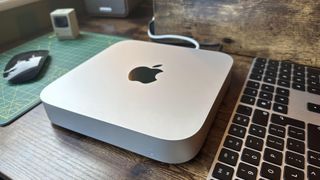These are the macOS features you're missing out on when using an Intel Mac
Intel Macs are on the way out — finally.

In June 2020, Apple announced plans to no longer use Intel chips in its Mac computers and instead use native silicon. A few months later, the first Apple silicon computers arrived. Since then, Intel-based devices have slowly left the Mac lineup. And, as of today, the Mac Pro is the only Intel computer the company still sells, and that model is expected to be replaced in the coming months.
Whether you are an existing Intel Mac user considering upgrading or a budget shopper wondering whether that older MacBook Pro with Intel on sale is good enough to buy, there's much to consider. This starts with a look at which features are exclusive to Apple silicon devices and extends to whether the older machines have enough oomph inside to get your tasks done.
Key macOS features only on Apple silicon Macs
There aren't all that many features that are only available on M-series Macs. However, that list is expected to grow over the coming years as technical advances further separate Intel Macs and ever-newer Apple silicon models.
Among the exclusive features:
Better Dictation
An Apple silicon Mac includes a few dictation features that aren't available on older computers. When activated, dictation allows you to dictate text anywhere you can type it. On newer devices, dictation requests are possible in multiple languages without an internet connection, plus the service can conveniently be turned off when no speech is detected for 30 seconds.
Are you looking for more? On the M-series, Macs can also dictate emojis. You heard correctly. If you don't know the name of emojis beyond "heart," "sad face," and "poop," you're probably out of luck.
Master your iPhone in minutes
iMore offers spot-on advice and guidance from our team of experts, with decades of Apple device experience to lean on. Learn more with iMore!

More to see in Apple Maps
There are two unique Maps features on Apple silicon Macs. The first is an interactive globe feature that allows you to zoom out to see the big picture. Once fully zoomed out, you can then see Earth floating in space. From there, you can easily zoom in on any location you wish to see. New Macs also show cities with more details in the app, including elevation, roads, trees, buildings, landmarks, and more in select cities.
Live Captions
Currently in public beta on macOS Ventura, Live Captions can be accessed wherever audio can be heard, such as in Podcasts and FaceTime. It's a terrific way to see audio displayed in real-time on your computer screen. Currently, it's only available on Apple silicon machines; it's not available in all languages, countries, or regions.
Portrait mode in FaceTime
During a FaceTime call on Apple silicon Macs, there's an option to enable Portrait mode, which automatically blurs your background. In doing so, the visual focus remains on you, but you can switch it off anytime.
And then there's battery life and performance
Having an Apple silicon vs. Intel Mac also comes with two overall advances that can't be mistaken: better battery life and increased performance.
Apple was criticized for offering poor battery life on MacBooks, but with Apple silicon, that's no longer the case. The last 16-inch Intel MacBook Pro provided 13 hours of charge, while the final MacBook Air with an Intel chip also offered 13 hours. The current models provide 220-240 hours between charges.
Processor benchmarks also show significant improvements between the current Apple silicon models and final Intel versions.
The MacBook Air (2022) received CPU benchmark scores of 1872 and 8735 for single-core and multi-core, respectively, according to Geekbench. The 16-inch MacBook Pro (2023) has a single-core score of 1961 and 15061 for multi-core. The final Intel model featured a score of 1078 and 6785 for single-core and multi-core.
Final thoughts
You could argue that the list of exclusive features to Apple silicon Macs isn’t long and won’t be an issue for most users. In addition, significant battery life and performance upgrades exist between the final Intel machines and current Apple silicon models. This could be enough for users to upgrade and avoid the discount rack by buying a late-model Mac with Intel and moving to an M2 Mac mini.
With rumors of an M3 series of Macs already on the way for a 2023 release, there’s no better time to move to Apple silicon. Check out all of the best Macs on the market, including the all-new M2 Mac mini.

Bryan M. Wolfe has written about technology for over a decade on various websites, including TechRadar, AppAdvice, and many more. Before this, he worked in the technology field across different industries, including healthcare and education. He’s currently iMore’s lead on all things Mac and macOS, although he also loves covering iPhone, iPad, and Apple Watch. Bryan enjoys watching his favorite sports teams, traveling, and driving around his teenage daughter to her latest stage show, audition, or school event in his spare time. He also keeps busy walking his black and white cocker spaniel, Izzy, and trying new coffees and liquid grapes.